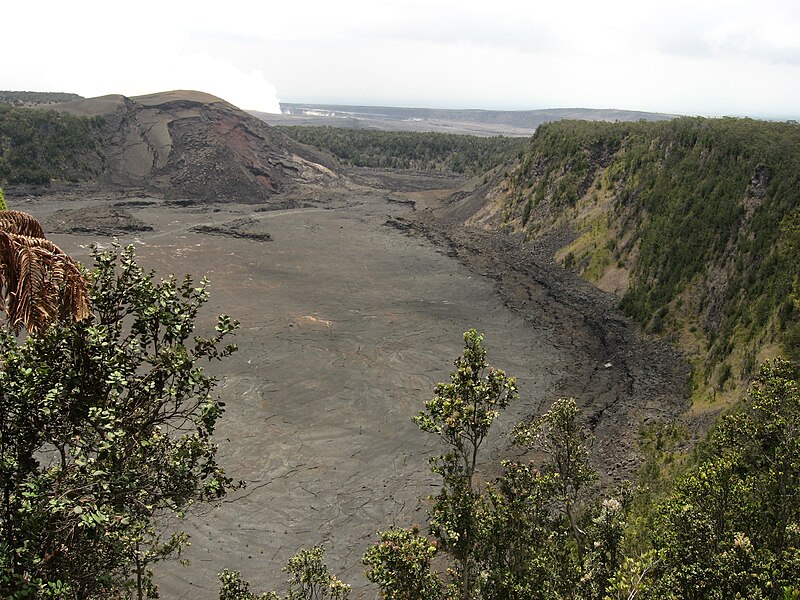File:Kīlauea Iki, Hawaiʻi Volcanoes National Park, Hawaii (4528782999).jpg

Original file (2,816 × 2,112 pixels, file size: 3.19 MB, MIME type: image/jpeg)
Captions
Captions
Summary edit
| DescriptionKīlauea Iki, Hawaiʻi Volcanoes National Park, Hawaii (4528782999).jpg |
Kīlauea Iki is a pit crater which is next to the main summit caldera of Kīlauea. In August 1959, a swarm of deep earthquakes was detected by the Hawaiian Volcano Observatory. In October it was indicated by seismographs that Kilauea summit was filling with magma. This formed a new lava shield, named Pu'u Pua'i (gushing hill). Some of the most impressive parts of the eruption were the lava fountains that flowed from Puʻu Puaʻi. By November 17, the fountain was reaching 60–80 meters tall with occasional bursts as high as 180 meters. The fountain grew to over 320 meters on November 18. On November 21, the lava lake was over a meter deep over the vent causing ripples across the surface of the lava lake causing lava on the shores to break like waves on a beach. At 7:25 p.m. local time on November 21, the fountain went from 210 meters tall to a few gas bubbles in less than 40 seconds. Some of the fountains were extraordinarily high, reaching nearly 580 m (1,900 ft), among the highest ever recorded. The first episode had 31 million cubic meters of lava flow into Kīlauea Iki with 1 million cubic meters draining back. During the following episodes, a total of 71 million cubic meters of lava was ejected during a month long eruption that stopped on December 20, 1959. Only 8 million cubic meters of lava remained, 63 million cubic meters of lava drained back into Kīlauea magma reservoir. Often the lava drainback had a higher rate of flow than the eruptions. On December 15, the highest flow of lava was measured at 1.45 million cubic meters per hour. With every filling and draining of the lava lake, a 'black ledge' was formed along the rim of the crater which is now 15–60 meters wide and 15 meters tall. During lava drainbacks, a giant counter-clockwise whirlpool would form. Drivers may view Kīlauea Iki from either a lookout point or the trailhead parking lot. Currently guests can hike across Kīlauea Iki from Byron Ledge which overlooks the crater as well as walking along the crater floor on what once was a lake of lava. Even after 50 years, the surface is still warm to the touch. Rainwater seeps into the cracks and makes contact with the extremely hot rock below and steam is emitted from various surface cracks. The steam and some rocks are hot enough to cause serious burns. en.wikipedia.org/wiki/K%C4%ABlauea_Iki en.wikipedia.org/wiki/Wikipedia:Text_of_Creative_Commons_... |
| Date | |
| Source | Kīlauea Iki, Hawaiʻi Volcanoes National Park, Hawaii |
| Author | Ken Lund from Reno, Nevada, USA |
| Camera location | 19° 24′ 59.24″ N, 155° 14′ 34.79″ W | View this and other nearby images on: OpenStreetMap |
|---|
Licensing edit
- You are free:
- to share – to copy, distribute and transmit the work
- to remix – to adapt the work
- Under the following conditions:
- attribution – You must give appropriate credit, provide a link to the license, and indicate if changes were made. You may do so in any reasonable manner, but not in any way that suggests the licensor endorses you or your use.
- share alike – If you remix, transform, or build upon the material, you must distribute your contributions under the same or compatible license as the original.
| This image was originally posted to Flickr by Ken Lund at https://flickr.com/photos/75683070@N00/4528782999. It was reviewed on 9 January 2017 by FlickreviewR and was confirmed to be licensed under the terms of the cc-by-sa-2.0. |
9 January 2017
File history
Click on a date/time to view the file as it appeared at that time.
| Date/Time | Thumbnail | Dimensions | User | Comment | |
|---|---|---|---|---|---|
| current | 03:10, 9 January 2017 |  | 2,816 × 2,112 (3.19 MB) | Holly Cheng (talk | contribs) | Transferred from Flickr via Flickr2Commons |
You cannot overwrite this file.
File usage on Commons
The following page uses this file:
Metadata
This file contains additional information such as Exif metadata which may have been added by the digital camera, scanner, or software program used to create or digitize it. If the file has been modified from its original state, some details such as the timestamp may not fully reflect those of the original file. The timestamp is only as accurate as the clock in the camera, and it may be completely wrong.
| Camera manufacturer | Canon |
|---|---|
| Camera model | Canon PowerShot A540 |
| Exposure time | 1/500 sec (0.002) |
| F-number | f/4 |
| Date and time of data generation | 15:46, 15 April 2010 |
| Lens focal length | 5.8 mm |
| Orientation | Normal |
| Horizontal resolution | 180 dpi |
| Vertical resolution | 180 dpi |
| File change date and time | 15:46, 15 April 2010 |
| Y and C positioning | Centered |
| Exif version | 2.2 |
| Date and time of digitizing | 15:46, 15 April 2010 |
| Meaning of each component |
|
| Image compression mode | 5 |
| APEX shutter speed | 8.96875 |
| APEX aperture | 4 |
| APEX exposure bias | −0.66666666666667 |
| Maximum land aperture | 2.75 APEX (f/2.59) |
| Metering mode | Pattern |
| Flash | Flash did not fire, compulsory flash suppression, red-eye reduction mode |
| Keywords | Hawaii |